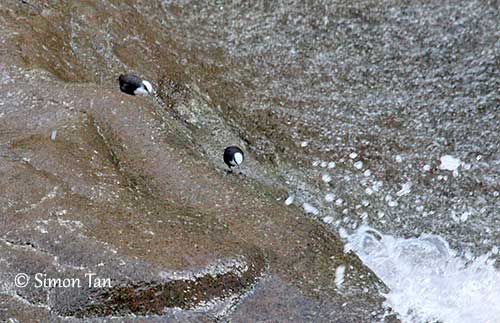
Fr: Cincle à tête blanche
Ang: White-capped Dipper
All: Weißkopf-Wasseramsel
Esp: Mirlo-acuático Coroniblanco
Ita: Merlo acquaiolo testabianca
Nd: Witkopwaterspreeuw
Sd: vitkronad strömstare
Photographers:
Roger Ahlman
Pbase Galleries Peru and Ecuador
Didier Buysse
Vision d’Oiseaux
Simon Tan
PBase Bird galleries
Text by Nicole Bouglouan
Sources:
HANDBOOK OF THE BIRDS OF THE WORLD Vol 10 by Josep del Hoyo-Andrew Elliott-David Christie - Lynx Edicions - ISBN: 8487334725
BIRDS OF SOUTH AMERICA – Passerines - by Robert S. Ridgely and Guy Tudor – HELM Field Guides – ISBN: 9781408113424
WRENS, DIPPERS AND THRASHERS by Brewer David – illustrated by Barry Kent Mackay- Yale University Press - ISBN: 0300090595
Neotropical Birds – Cornell Lab of Ornithology
Wikipedia, la enciclopedia libre
SORA Searchable Ornithological Research Archive (Blair O. Wolf)
WING-FLASHING BEHAVIOR IN THE WHITE-CAPPED DIPPER
By M. Josephine Babin
Observations on the nesting of White-capped Dipper (Cinclus leucocephalus) in Ecuador
By Harold F. Greeney
White-capped Dipper
Cinclus leucocephalus
Passeriformes Order – Cinclidae Family
INTRODUCTION:
The White-capped Dipper is a South American species. Three subspecies share the Andean range and only differ in coloration and amount of white in their plumage.
Like other dippers, it is typically found in fast-flowing streams and rivers in mountains. However, it forages by submerging the head underwater, but it has never been seen diving beneath the surface, unlike other dippers (except the second south American species). Its strong toes and sharp claws allow the bird to walk easily on slippery rocks.
Although being evaluated as Least Concern, the species is affected by both pollution and siltation due to mining operations.

DESCRIPTION OF THE BIRD:
Biometrics:
Length: 15-17 cm
Weight: 44 g
The adult of nominate race has blackish-brown upperparts and underparts, the latter including breast sides, belly and flanks. The underwing is mostly greyish-black. There is some white on the inner webs of secondaries, visible from below while the bird flicks its wings.
On the head, crown and nape are white, finely spotted and streaked dark. Chin and throat are white, separated from crown and nape by dark band extending from lores back to the sides of the nape.
The bill is black. The eyes are brown. Legs and feet are pale greyish-blue. The pale claws are long and well-curved.
Male and female have similar plumage, but the male is slightly larger than female.
The juvenile has narrow whitish edges to upperwing-coverts and tertials. The pale crown shows heavier streaking while throat and breast are streaked dark. The belly has whitish mottling.
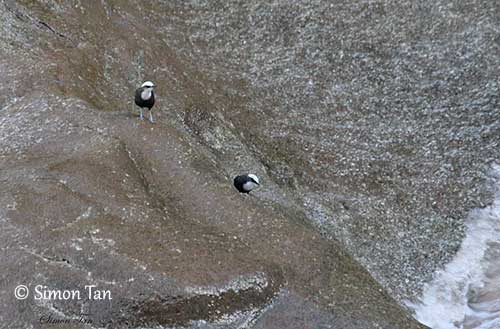
SUBSPECIES AND RANGE:
The White-capped Dipper has three recognized subspecies.
C.l. leucocephalus (described and displayed) is found in the Andes of Peru and NW Bolivia.
C.l. rivularis is found in St Marta Mountains in N Colombia. This race is paler, with grey instead of blackish-brown plumage, and throat spotted with grey.
C.l. leuconotus (displayed) occurs in the Sierra de Perijá and in the Andes from W Venezuela S to Ecuador. This one has white patch on centre of back, and more white below extending down to upper belly. It is smaller than nominate.
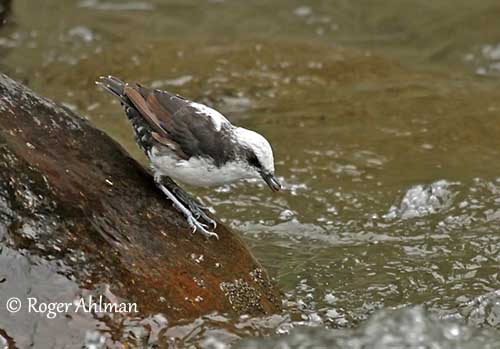
HABITAT:
The White-capped Dipper frequents fast-flowing clear water streams and rivers at middle elevation in N Andes. It is usually seen in rocky rivers, rapids and waterfalls, bordered by rocky cliffs or steep rocky banks. It also frequents forested areas and occurs in more open areas at higher elevations.
This species is visible from the foothills to lower páramo area, up to 3900 metres, and sometimes higher, up to 4200 metres. But generally, it occurs above 1000 metres. But the elevation varies according to the range.
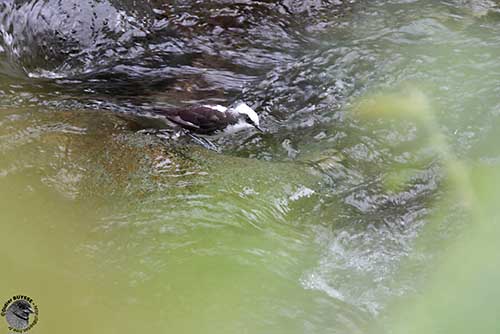
CALLS AND SONGS: SOUNDS BY XENO-CANTO
The five dipper species have similar calls and songs. The White-capped Dipper’s contact calls and alarm calls are loud and high-pitched “zzit” or “clink” fairly penetrating to be heard by other dippers against the noise of the running water. These sounds are repeated 2-4 times. A sharp “dzeet” is often given in flight.
The song is a loud, musical, bubbling sound given by both adults all year round.
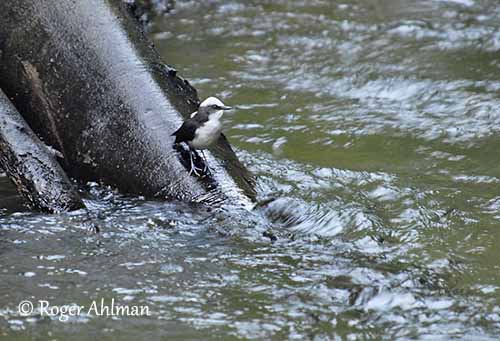
BEHAVIOUR IN THE WILD:
The White-capped Dipper feeds on wide variety of aquatic invertebrates such as Simuliidae (blackfly larvae), Ephemeroptera (mayfly nymphs) and Trichoptera (caddis-fly larvae). Some terrestrial preys such as earthworms are taken too while foraging in the vegetation along the streams.
It forages between rocks and wades in shallow water, probes among pebbles, gleans from the wet rocks and picks preys from the vegetation.
The White-capped Dipper, like the other S American dipper, the Rufous-throated Dipper, has not been observed diving underwater. It usually submerges only the head and often dips the bill.
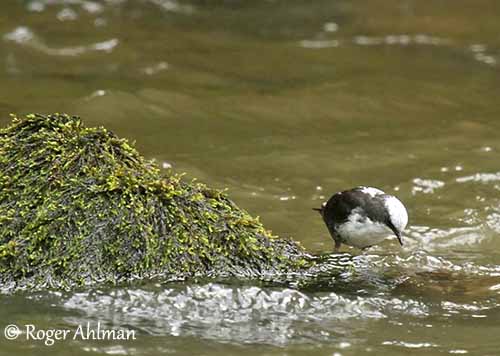
While foraging by waking among the rocks, it flicks the wings and the white underwing patches appear. The use of “wing-flashing” is not well known. This action is not associated with foraging behaviour, nor described as display.
As the dipper walks on slippery rocks with quick, jerky movements interspersed with pauses, the bird spread the wings and displays the white underwing patch for a few seconds, before to plunge the head underwater, probably to catch a prey.
The wing-spreading action still needs to be explained, but it may be used to balance the body on the slippery rocks when the bird stops, or to disturb the preys before to catch them. More information is required.
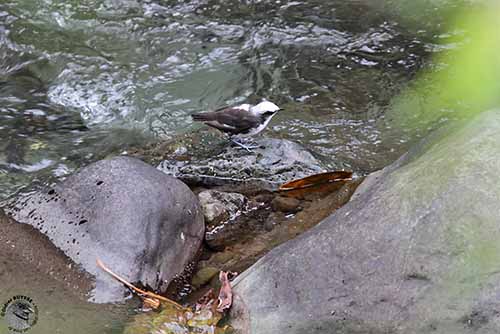
The White-capped Dipper maintains a linear territory along streams and rivers, and the size of this area depends on prey availability.
The species is territorial during the breeding season, and often all year round. The displays are poorly known, but usually, the Cinclidae performs fairly similar courtship and advertising displays.
The male approaches the female, running around her while quivering the wings and calling. Aerial displays including high display flights and chasing flights accompanied by songs are observed in most species.
They are primarily monogamous, but some males may be polygynous in areas where females outnumber males along the same river. There is usually less than one pair/km, or two pairs/km.
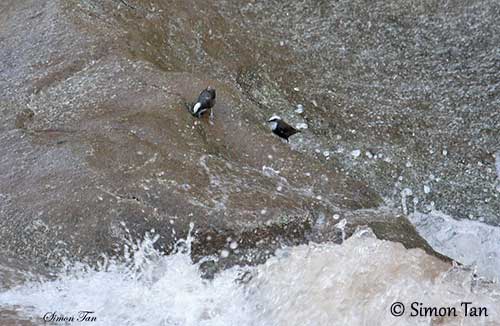
The White-capped Dipper is resident in its range, with possibly some altitudinal movements outside the breeding season.
The flight is fast and direct, often low over the water. The bird usually follows the watercourse.
REPRODUCTION OF THIS SPECIES:
The breeding season is unknown and varies according to the range. Birds in breeding conditions have been observed from February to September in the northern parts of the range, whereas eggs were found in November in Bolivia.
From some observations, the White-capped Dipper’s nest is described as a cup open from above and made with moss. Domed nests are also described.
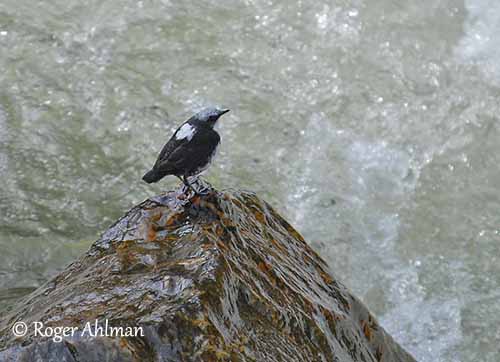
From another observation, the nest is usually adjacent to fast-flowing mountain streams, bordered by vertical rocky cliffs or bridge supports. It can be placed in vertical crevice, sheltered ledge or small cavity, generally 1-3 metres above the water.
The bulky structure is often globular, made with wet moss and rootlets. There is a central side entrance. The inner cup is lined with bamboo leaves (Chusquea) and other pieces of plant matter. The nest is made of several overlapping layers of tightly compacted bamboo leaves. It is sometimes placed in moss-covered cliff behind a waterfall.
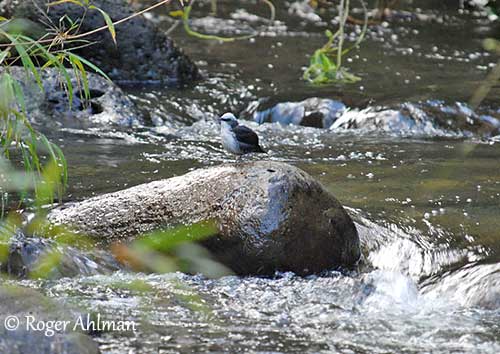
The female lays 1-2 pure white eggs. There is no more information for this species, but usually in Cinclidae, both parents feeds the chicks which hatch after an incubation period of 14-18 days. The nesting period lasts between 3 and 4 weeks. The adults still feed them after fledging for several days, while the young hide among rocks or vegetation.
PROTECTION / THREATS / STATUS:
The White-capped Dipper is usually fairly common and widespread throughout its range. However, this species can be affected by water pollution, especially in Ecuador in Quito area.
But the global population appears to be stable, and currently, the White-capped Dipper is evaluated as Least Concern.
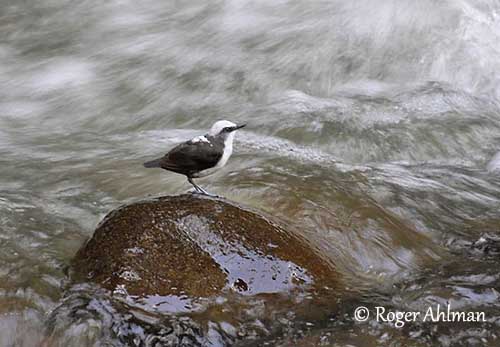
C.l. leucocephalus
Nominate race
C.l. leucocephalus
Nominate race
C.l. leucocephalus
Nominate race